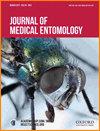Optimization of artificial membrane feeding system for lone star ticks, Amblyomma americanum (Acari: Ixodidae), and experimental infection with Rickettsia amblyommatis (Rickettsiales: Rickettsiaceae)
IF 2
3区 农林科学
Q1 ENTOMOLOGY
引用次数: 0
Abstract
With the introduction of siliconized artificial membranes, various artificial feeding systems (AFS) for hard ticks (Ixodidae) have been developed over the last decades. Most AFS utilize similar core components but employ diverse approaches, materials, and experimental conditions. Published work describes different combinations of the core components without experimental optimizations for the artificial feeding of different tick species. Amblyomma americanum L., (Acari: Ixodidae) (lone star tick) is a known vector and reservoir for diverse tick-borne pathogens, such as Rickettsia amblyommatis and Ehrlichia chaffeensis. Ongoing environmental changes have supported the expansion of A. americanum into new habitats, contributing to increased tick-borne diseases in endemic areas. However, a significant knowledge gap exists in understanding the underlying mechanisms involved in A. americanum interactions with tick-borne pathogens. Here, we performed a systematic analysis and developed an optimized AFS for nymphal lone star ticks. Our results demonstrate that Goldbeater’s membranes, rabbit hair, hair extract, and adult lone star ticks significantly improved the attachment rate of nymphal ticks, whereas tick frass and frass extract did not. With the optimized conditions, we achieved an attachment rate of 46 ± 3% and a success rate of 100% (i.e., one or more attached ticks) in each feeding experiment for nymphal lone star ticks. When fed on sheep blood spiked with R. amblyommatis, both nymphal and adult lone star ticks acquired and maintained R. amblyommatis, demonstrating the feasibility of studying A. americanum–pathogen interactions using AFS. Our study can serve as a roadmap to optimize and improve AFS for other medically relevant tick species.孤星蜱(Amblyomma americanum,Acari: Ixodidae)人工膜饲喂系统的优化及立克次体(Rickettsiales: Rickettsiaceae)的实验感染
随着硅化人工膜的问世,过去几十年来,针对硬蜱(Ixodidae)的各种人工饲喂系统(AFS)也应运而生。大多数人工饲喂系统都使用类似的核心部件,但采用的方法、材料和实验条件各不相同。已发表的作品介绍了不同核心成分的组合,但没有针对不同蜱虫物种的人工喂养进行实验优化。美国蜱(Amblyomma americanum L.,Acari: Ixodidae)(孤星蜱)是已知的多种蜱传病原体(如伏立克次体和沙弗氏艾氏菌)的载体和贮藏库。持续的环境变化支持美洲蜱向新的栖息地扩张,导致地方病流行地区的蜱传疾病增加。然而,在了解美洲蜱与蜱传病原体相互作用的内在机制方面还存在着巨大的知识差距。在这里,我们进行了系统分析,并开发出了针对孤星蜱若虫的优化 AFS。我们的结果表明,金贝特膜、兔毛、毛发提取物和成年孤星蜱能显著提高若虫蜱的附着率,而蜱糠和蜱糠提取物则不能。在优化条件下,我们在每次喂养实验中都能使若虫孤星蜱的附着率达到 46 ± 3%,成功率达到 100%(即附着一只或多只蜱)。当喂食添加了伏兔病毒的羊血时,若虫和成虫孤星蜱都能获得并维持伏兔病毒,这证明了使用 AFS 研究美洲大蜱-病原体相互作用的可行性。我们的研究可以作为优化和改进其他医学相关蜱物种 AFS 的路线图。
本文章由计算机程序翻译,如有差异,请以英文原文为准。
求助全文
约1分钟内获得全文
求助全文
来源期刊
CiteScore
4.60
自引率
14.30%
发文量
207
审稿时长
3-8 weeks
期刊介绍:
Journal of Medical Entomology is published bimonthly in January, March, May, July, September, and November. The journal publishes reports on all phases of medical entomology and medical acarology, including the systematics and biology of insects, acarines, and other arthropods of public health and veterinary significance. In addition to full-length research articles, the journal publishes Reviews, interpretive articles in a Forum section, Short Communications, and Letters to the Editor.

 求助内容:
求助内容: 应助结果提醒方式:
应助结果提醒方式:


